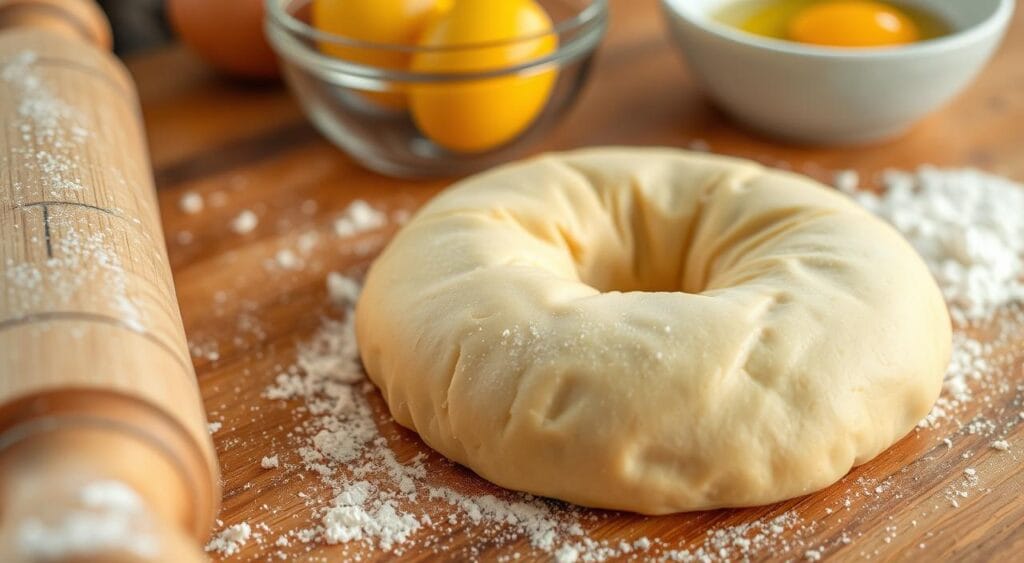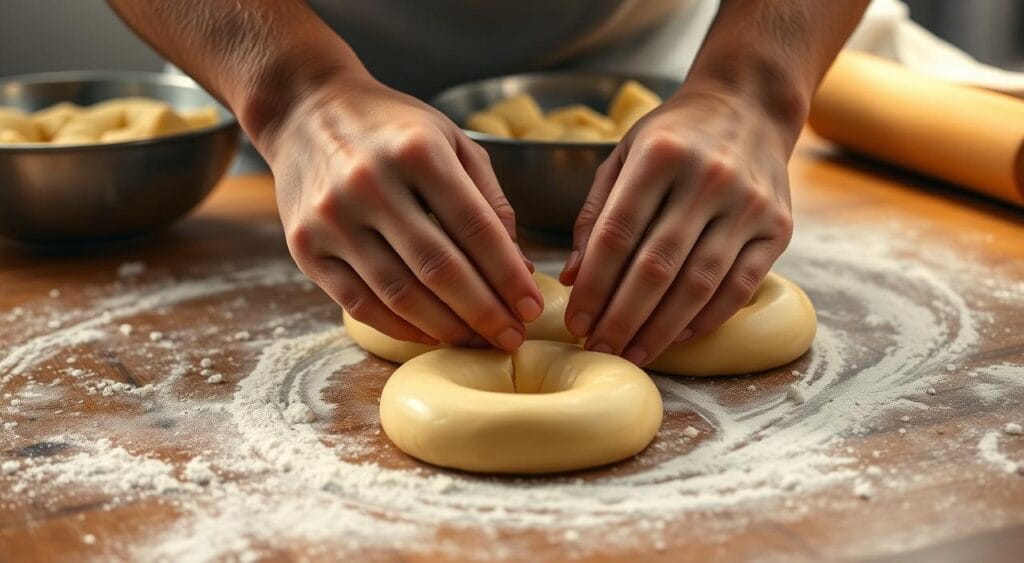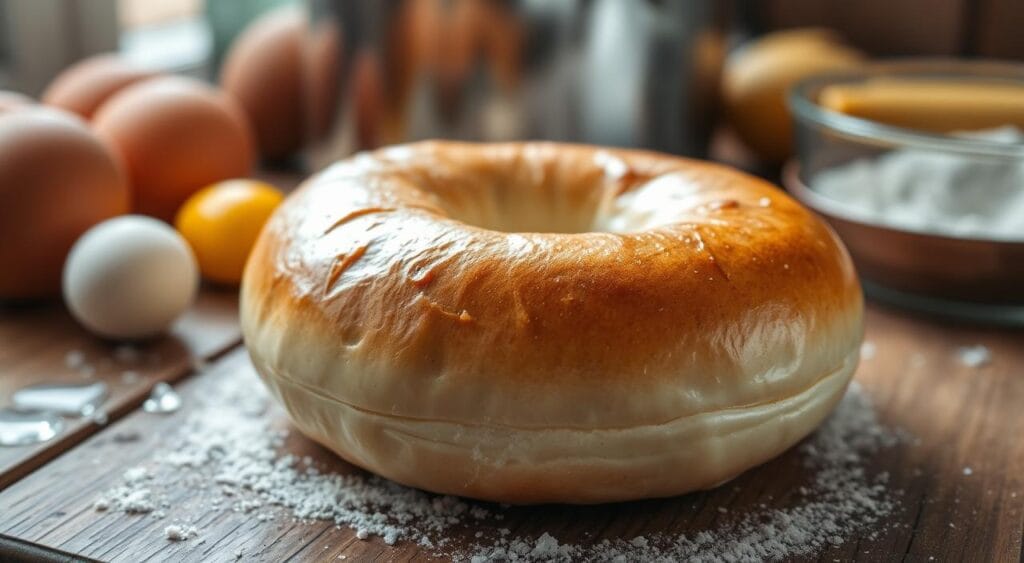Table of Contents
The sun peeked through the kitchen window, filling the air with the smell of fresh Egg Bagel Recipe. It brought back memories of my childhood in my grandmother’s cozy kitchen. Her skilled hands shaping the dough and the golden-brown crust’s crunch are unforgettable.
Today, I’m excited to share a recipe that brings back those comforting feelings – homemade Egg Bagel Recipe. These treats are a joy to the senses and show the beauty of homemade baking. Let’s make these fluffy, flavorful egg bagels together. They’ll make your mornings better and fill your home with the smell of fresh bread.
Key Takeaways
- Discover the unique flavor and texture of homemade egg bagels
- Learn a step-by-step guide to crafting perfect egg bagels from scratch
- Explore the history and benefits of incorporating eggs into bagel dough
- Understand the essential ingredients and equipment needed for this recipe
- Master the techniques for achieving the perfect dough consistency and shaping
- Uncover the secrets to the boiling process for authentic bagel texture
- Bake golden-brown, delicious egg bagels that will elevate your breakfast routine
Understanding the Magic of Egg Bagel Recipe: What Makes Them Special
Egg bagels are a favorite breakfast treat for many. They have a unique taste and texture that makes them stand out. Let’s explore the history and benefits of egg bagels and why they’re so loved.
The Rich History of Traditional Egg Bagel Recipe
Egg bagels come from the Jewish communities of Eastern Europe. They were made with eggs in the dough, adding richness and a chewy texture. Over time, they became a staple in American breakfasts.
Benefits of Adding Eggs to Bagel Dough
Eggs in the dough make egg bagels more than just tasty. They add protein, vitamins, and minerals, making them a nutritious start to the day. The result is a tender, chewy texture that’s unlike regular bagels. Try a freshly baked egg bagel recipe for a special treat.
How Egg Bagel Recipe Differ from Regular Bagels
Egg bagels and regular bagels look similar but taste and feel different. Egg bagels are richer, with a buttery flavor and a softer texture. They also have a darker color, making them easy to spot. Whether you want a classic breakfast recipe or a tasty bagel sandwich, egg bagels are a great choice.
“Egg bagels are the perfect breakfast choice, combining the classic bagel texture with a rich, indulgent flavor that will start your day off right.”
Essential Ingredients and Equipment for Your Egg Bagel Recipe
Making the perfect Egg Bagel Recipe for breakfast needs a few important ingredients and tools. Whether you’re an experienced baker or new to cooking, the right supplies are key. They help you get that chewy texture and rich taste.
To start, you’ll need these ingredients:
- Bread flour or all-purpose flour
- Eggs, preferably large or extra-large in size
- Yeast, either active dry or instant
- Warm water
- Salt
- Sugar or honey (optional for sweetness)
For equipment, you’ll need:
- A large mixing bowl for kneading the dough
- A rolling pin for shaping the bagels
- A large pot for boiling the bagels
- A baking sheet lined with parchment paper for baking
- A pastry brush for egg washing the bagels (optional)
With these ingredients and tools, you’re ready to make delicious, homemade egg bagels. They’ll be the highlight of your morning meal.
Mastering the Perfect Egg Bagel Dough
Creating the perfect egg bagel recipe starts with mastering the dough. You need to get the dough’s consistency right and know how to knead it. This is the key to baking the perfect breakfast.
Achieving the Right Dough Consistency
The dough’s hydration level is crucial for a successful egg bagel. Aim for a dough that’s slightly tacky but firm. Use a digital scale to measure your ingredients accurately. This ensures the right balance of flour, water, and other ingredients.
- Use a digital scale to measure your ingredients accurately.
- Adjust the amount of water gradually until you reach the desired texture.
- Knead the dough thoroughly to develop the gluten structure.
Kneading Techniques for Better Texture
Proper kneading is key for the chewy texture of egg bagels. Try different techniques to find what works best for you.
- Try the “slap and fold” method to develop the dough’s structure.
- Use a stand mixer with a dough hook attachment for a more hands-off approach.
- Knead the dough for at least 10 minutes to ensure it’s well-developed.
Signs Your Dough is Ready
Knowing when your dough is perfectly kneaded is crucial. Look for these signs:
- The dough should pass the “window pane test,” where a small piece can be stretched thin without tearing.
- It should feel smooth, elastic, and slightly tacky to the touch.
- When poked, the dough should slowly spring back, indicating a well-developed gluten structure.

Mastering egg bagel dough is the first step to baking perfect breakfasts at home. Dive into the process and enjoy making your own egg bagels!
Shaping and Proofing Your Egg Bagel Recipe
Making the perfect egg bagel recipe is more than just mixing the dough. Shaping and proofing are key to get that chewy texture and golden crust. Let’s explore the steps to shape and proof your egg bagels.
Shaping the Dough
Begin by dividing the dough into pieces, about 4-5 ounces each. Roll each into a smooth ball. Then, use your index finger to poke a hole in the middle and stretch it into a bagel shape.
Make sure the dough is stretched evenly. Avoid overworking it to keep it soft.
Achieving the Right Shape
- Roll the dough into a smooth, even ring.
- The hole in the center should be 1-1.5 inches wide for even cooking.
- Pinch the ends together to seal the ring and make a perfect bagel shape.
Proofing for Perfection
After shaping, let your egg bagels rise. Place them on a parchment-lined baking sheet, cover with a towel, and let them proof for 30-45 minutes at room temperature. This step relaxes the dough and makes it chewy.
Watch your bagels while they proof. The rise time can change based on temperature and humidity. They should puff up by about 50% when ready for baking.
| Proofing Time | Ideal Temperature | Humidity Range |
|---|---|---|
| 30-45 minutes | 70-75°F (21-24°C) | 50-60% |
With the right shaping and proofing, you’ll have freshly baked, homemade egg bagels. They’re perfect for your favorite bagel sandwich creations.

The Boiling Process: Key to Authentic Bagel Texture
The boiling process is key to a perfect egg bagel recipe. It makes the bagel chewy and enhances its flavor. This step is crucial for a great morning meal.
Water Bath Temperature Guidelines
To get your egg bagel recipe just right, keep the water at 212°F to 220°F (100°C to 104°C). This high heat creates a thin, shiny crust. It also keeps the inside soft and chewy.
Timing Your Boiling Process
Timing is everything in boiling. Boil your dough for 1 to 2 minutes on each side. This quick hot water exposure sets the shape and texture.
Adding Honey or Malt for Enhanced Flavor
Adding honey or malt to the boiling water boosts flavor. These sweeteners make the bagel taste better and look golden.
“The boiling process is the true test of a bagel’s authenticity. It’s what sets them apart from ordinary bread.”
Mastering the boiling process makes your egg bagels perfect for breakfast. Paying attention to detail is crucial for the perfect bite.

Baking Instructions for Golden-Brown Egg Bagel Recipe
Now it’s time to bake your egg bagels. Preheat your oven to 450°F (230°C). Line a baking sheet with parchment paper or a silicone mat. Place the boiled and drained egg bagels on the sheet, leaving space for even baking.
Brush the tops with a beaten egg wash for a shiny, golden crust. Use a pastry brush for an even coat. You can also add sesame seeds or coarse salt for extra flavor.
Bake for 20-25 minutes until the bagels are golden brown. Watch them closely to avoid over-browning. After baking, let the bagels cool on a wire rack for at least 10 minutes. This step helps them set and get their final texture.
FAQ
What makes egg bagels different from regular bagels?
Egg bagels have eggs, making them richer and sweeter than plain bagels. The eggs also make the crust golden-brown when baked.
Do I need any special equipment to make homemade Egg Bagel Recipe?
You don’t need special equipment, but a few items help. A large pot for boiling, a baking sheet, and a dough hook for your mixer are key.
How do I get the signature chewy texture of authentic bagels?
The secret to chewy bagels is boiling them. Boil the dough in water, maybe with honey or malt. This makes the outside chewy.
Can I make Egg Bagel Recipe dough ahead of time?
Yes, you can make the dough ahead. After the first rise, refrigerate it for up to 3 days. This lets the flavors grow and makes shaping easier.
How long do homemade Egg Bagel Recipe stay fresh?
Egg bagels stay fresh for 3 days in an airtight container. Freeze them for up to 2 months for longer storage.
Can I customize the flavor of my Egg Bagel Recipe?
Yes, you can! Try sesame seeds, everything seasoning, or chives for a unique taste. Bacon or onions are great too.

